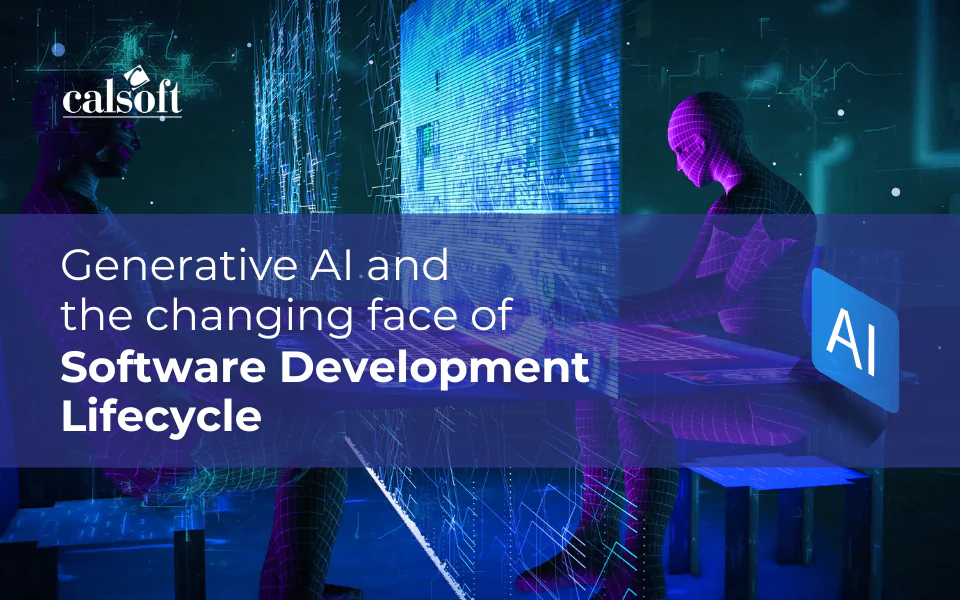Meta Description: Explore how Generative AI, like ChatGPT and DALL-E, is transforming software development, enhancing coding and debugging, and introducing risks like cybersecurity concerns.
Long before ChatGPT and DALL-E grabbed headlines, AI tools were subtly transforming workflows.
We had machine learning frameworks like TensorFlow, PyTorch, and Scikit-learn. Data miners and analysts had SAS, IBM SPSS, and RapidMiner. There were robotic process automation tools like UiPath, Blue Prism, etc. Testing teams had Selenium, QTP, and more.
The list goes on and on and on.
What ChatGPT and DALL-E did was accelerate the AI hype, underscoring their vast potential.
McKinsey research highlights this impact, estimating that generative AI could contribute a staggering $4.4 trillion annually to the global economy.
This pioneering technology is transforming a wide range of industries beyond tech. While high-profile achievements like AlphaGo’s triumph in Go have garnered attention, it’s the everyday uses of generative AI in writing, art, and data management that are truly reshaping various sectors.
We’re at the cusp of a transformative era with technologies like AI reshaping software development. Today, we delve into understanding these changes and their extensive impacts.
What is the Potential of Gen AI in Software Development?
The potential of Generative AI (Gen AI) in software development is immense, offering transformative changes across various aspects of the field. Here are some key points to consider:
- Automated Coding and Debugging: Gen AI tools like GitHub Copilot are revolutionizing how developers write and debug code. By understanding natural language prompts, these AI systems can suggest code snippets, detect bugs, and even write entire functions, significantly reducing development time and increasing efficiency.
- Enhanced Code Quality and Architecture: Beyond just writing code, Gen AI can improve the overall quality and architecture of software. By analyzing vast datasets of code, AI can identify best practices and recommend architectural improvements, leading to more robust and scalable applications.
- Personalized Software Development: Gen AI’s ability to process and understand large datasets allows for more personalized development processes. It can tailor software solutions to specific user needs and preferences, leading to more user-centric products.
- Accelerated Development Cycles: The integration of Gen AI in software development tools enables faster development cycles. AI can automate mundane and repetitive tasks, freeing developers to focus on more complex and creative aspects of software design and implementation.
- Improved Testing and Quality Assurance: In the realm of testing, Gen AI can automate the creation of test cases and identify potential failure points, leading to higher software quality and reliability.
How are LLMs Changing the Way We Build Software?
Large Language Models (LLMs) are revolutionizing software development by bringing a new level of intelligence and efficiency to coding practices. Here’s how they are changing the landscape:
1. Code Completion and Prediction
LLMs, such as those used in GitHub Copilot, are adept at predicting and completing code. Given a partial code snippet or a functional description, these models can generate the subsequent lines of code.
For instance, if a developer inputs a prompt like “write a Python function that transforms a NumPy array into a dictionary where the keys are the strings of the range over the first dimension of the array,” it would return the following code:
This capability significantly enhances productivity and reduces coding errors. It’s not just limited to simple functions; LLMs can assist in developing complex algorithms, debugging, and even suggesting best practices. This is especially beneficial for novice programmers, who might struggle with remembering specific syntax or understanding the nuances of a language.
2. Streamlining Complex Task Breakdown
The real leap forward will be when LLMs can understand and decompose complex software functionalities into smaller, implementable segments on their own. This would mean a shift from simply coding to a more conversational interaction, where the LLM acts like a full-stack developer, understanding high-level requirements and suggesting feasible implementations.
Here’s how conversational AI can practically help streamline complex tasks:
- Decomposes Projects: Conversational AI can break down complex projects into smaller, manageable tasks, facilitating a clear development path.
- Technology Recommendation: It can suggest appropriate technology stacks for each aspect of a project, tailored to its specific needs.
- Clarifies Objectives: AI aids in clarifying project goals by asking pertinent questions and ensuring a mutual understanding of the end goals.
- Identifies Challenges: Proactively identifies potential obstacles, allowing for preemptive solutions and smoother project progression.
- Fosters Collaboration: Enables seamless collaboration between team members by providing a common understanding and language for the project’s tasks.
- 3. Expanding Accessibility to Software Development
As LLMs continue to evolve, they will enable a wider range of individuals, not just seasoned developers, to create software. By accurately describing a desired software’s functionality in natural language, anyone could potentially direct the development of a software product.
Here are five key ways in which AI technologies are expanding accessibility:
- Simplified Code Generation: LLMs can translate natural language descriptions into code, significantly reducing the need for deep programming knowledge. This allows individuals from non-technical backgrounds to develop software based on their ideas and requirements.
Customized Solution Guidance: AI provides tailored advice for specific project needs, catering to various domains like healthcare, education, or business. It ensures that the software developed aligns closely with the unique requirements of different sectors.
Interactive Learning and Support: LLMs offer interactive guidance, making the learning process more intuitive for beginners. They can clarify concepts, suggest improvements, and provide instant feedback, enhancing the learning curve for new developers.
Error Detection and Correction: AI tools can identify and suggest corrections for coding errors or inefficiencies. This feature is especially beneficial for novice programmers, helping them avoid common pitfalls and improve their coding skills.
- Broadening Collaborative Opportunities: AI and LLMs enable collaboration between individuals with varying skill levels, fostering a more inclusive development environment. They bridge the gap between expert and novice developers, allowing for more diverse team composition and idea generation.
4. Facilitating Rapid Prototyping and Idea Generation
LLMs can provide outlines and sample codes for complex applications, aiding in rapid prototyping and idea generation. While they may not produce a complete, deployable application, they significantly reduce the time and effort needed to develop a workable prototype.
LLMs help businesses in rapid prototyping and idea generation that, in turn, helps:
- Accelerate Development: Speeds up the transition from concept to prototype.
- Enhance Creativity: Offers diverse coding solutions and approaches for innovative prototyping.
- Reduce Technical Barriers: Makes prototyping accessible to non-experts.
- Facilitate Problem-Solving: Helps identify and address potential issues early in development.
- Improve Efficiency: Streamlines the prototyping process, saving time and resources.
Boosting Developer Productivity with Generative AI
By automating routine coding tasks, Generative AI allows developers to focus on complex problem-solving and innovation. It streamlines coding processes and optimizes workflow efficiency in several impactful ways, including:
- Automates Routine Coding: Generative AI rapidly generates standard code snippets, reducing manual coding effort and increasing output.
- Enhances Debugging Efficiency: By identifying and suggesting fixes for bugs, it streamlines the debugging process, saving valuable time.
- Facilitates Code Optimization: AI suggests optimizations for existing code, ensuring better performance and resource utilization.
- Speeds Up Project Completion: It helps enhance agile project management by automating repetitive tasks. Developers can focus on complex problems, accelerating overall project timelines.
What are the Risks and Challenges of Using Generative AI in Software Development?
While Generative AI holds the promise of streamlined workflows and tailored software solutions in software development, it also presents a spectrum of risks and challenges:
1. They’re Error-Prone and Inaccurate at Times
Generative AI, despite its advanced capabilities, is not infallible and can produce code that is error-prone or inefficient. While it significantly accelerates the coding process, its output often necessitates careful review and correction by human developers.
This is particularly crucial in ensuring the accuracy and functionality of the final product. The AI’s role is akin to that of an advanced assistant, offering suggestions and performing tasks, but it lacks the nuanced understanding and critical thinking inherent to skilled developers.
Ultimately, the responsibility for the integrity and performance of the code lies with humans, who must oversee and refine the AI’s contributions to guarantee the quality of the software.
For example, look at the above ChatGPT prompt. The AI outlines a sequence of calculator inputs but introduces errors, likely due to a misinterpretation of the mathematical order of operations or rounding issues. It suggests a complex, multi-step calculation that results in an inaccurate final figure.
This illustrates that while conversational AI can assist with mathematical problems, its guidance can sometimes be erroneous and should be cross-checked.
2. Another Major Concern is Cybersecurity
AI-generated code can potentially introduce security vulnerabilities, either through inadvertent errors or by replicating flawed coding patterns learned from its training data. This necessitates rigorous security checks and balances in the development process to identify and rectify any such vulnerabilities.
A recent study by Deloitte on global AI early adopters found that over 40% of executives express significant or very significant worries about various AI-related risks.
The primary concern among these is “cybersecurity vulnerabilities.” Additionally, the study noted that the reasons behind these concerns differ from country to country.
As AI systems become more integrated into critical infrastructures, the potential for AI-exploited security breaches increases. Consequently, developers and cybersecurity experts must work in tandem to create advanced defensive strategies that evolve alongside AI capabilities.
This includes implementing proactive measures such as ethical AI frameworks, continuous security training data updates, and the development of AI systems that can detect and counteract threats autonomously.
Looking Ahead: The Importance of Mature Engineering Practices
Looking ahead, the integration of Generative AI (GenAI) in software development underscores the vital need for mature engineering practices. Implementing robust frameworks like continuous integration/continuous deployment (CI/CD) and embracing DevOps methodologies becomes crucial.
These practices are essential not just for harnessing GenAI effectively but also for managing and measuring the impact of process changes it brings.
Additionally, a well-defined AI operating model can guide organizations in aligning GenAI adoption with their strategic goals, cultural values, and existing processes, ensuring a balanced approach between innovation and organizational coherence.













